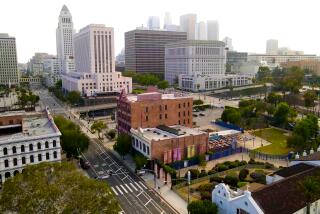Mission May Drop Plan to Build on Burial Site
- Share via
Mission San Diego de Alcala has all but abandoned controversial plans to build a parish hall atop Indian burials and historic mission ruins, Indian negotiators and the parish architect said Wednesday.
The Catholic Diocese of San Diego is nearing an agreement with the Kumeyaay Indians that will scrap plans for a meeting hall on the mission site, according to Indian negotiator Ron Christman. The odds “are better than 50-50” that a formal agreement will be announced this afternoon, he said.
Christman chairs the Kumeyaay committee that has negotiated for the past two weeks with mission representatives in an effort to preserve the site as an Indian cemetery.
Architect Harry Hallenbeck, a parishioner studying alternative locations for the meeting hall, confirmed Wednesday that mission priest Msgr. I. Brent Eagen has given up on the site. “The monsignor has indicated to me that he does not think it is realistic to build on the present site,” said Hallenbeck, referring to his conversations with Eagen over the past week.
Eagen, who has long guided the meeting hall project, has the authority to decide its fate. Through his spokesman, he declined comment on negotiations with the Kumeyaay.
Attorneys for the mission have suggested in negotiations that the plans to build the meeting hall on the disputed site are “dead in the water,” Christman said. “It looks like they are trying to find a way to capitulate without losing face.”
Another source close to the negotiations confirmed that the Kumeyaay have won major concessions from the diocese.
Mission spokesman William Finley confirmed that the mission will deliver a draft proposal to the Kumeyaay today or Friday. But he refused to discuss the content of the new offer, saying only that the future of the controversial site “is still up in the air.”
Several sticking points have delayed agreement between Indians and the diocese, according to Christman. One of these is a demand by the Kumeyaay that the site be consecrated and preserved in perpetuity as an Indian cemetery. Christman said mission attorneys have informally acknowledged that the lot is a cemetery, a point the mission has long disputed.
But the attorneys worry that consecrating the ground will open the diocese to charges of digging up a cemetery and strip the mission of its rights to build there in the future, Christman said.
The Kumeyaay have also asked the mission to rebury the Indian remains taken from the site in their original locations and to sod the entire lot, Christman said. In its reply, the mission has asked for guarantees against a lawsuit from those archeologists who oppose covering the early mission ruins on the site with dirt, he said.
The Kumeyaay expect the counterproposal by mission attorneys to address those concerns, according to Christman. “If we are not satisfied, we’ll start the legal wheels rolling.”
Attorneys Donald Worley for the mission and Robert Shull for the Kumeyaay did not return repeated phone calls Wednesday.
Even if a settlement is reached between the Kumeyaay and the mission, it will not end the meeting hall controversy. An Aug. 7 public hearing on the matter before the San Diego City Council would proceed regardless, according to a City Hall aide. “The Kumeyaay are just one part of this,” said Cynthia Vicknair, an aide to Councilwoman Judy McCarty. “We are concerned about the archeology uncovered as well.”
Archeologists are divided on the issue of covering up the early mission ruins on the site. At least one group has agreed to abide by the wishes of the Kumeyaay, who have claimed that the remains found alongside the ruins belong to their ancestors. But the mission has so far refused the Indians’ request for archeological data, Christman said.
More to Read
Sign up for Essential California
The most important California stories and recommendations in your inbox every morning.
You may occasionally receive promotional content from the Los Angeles Times.










